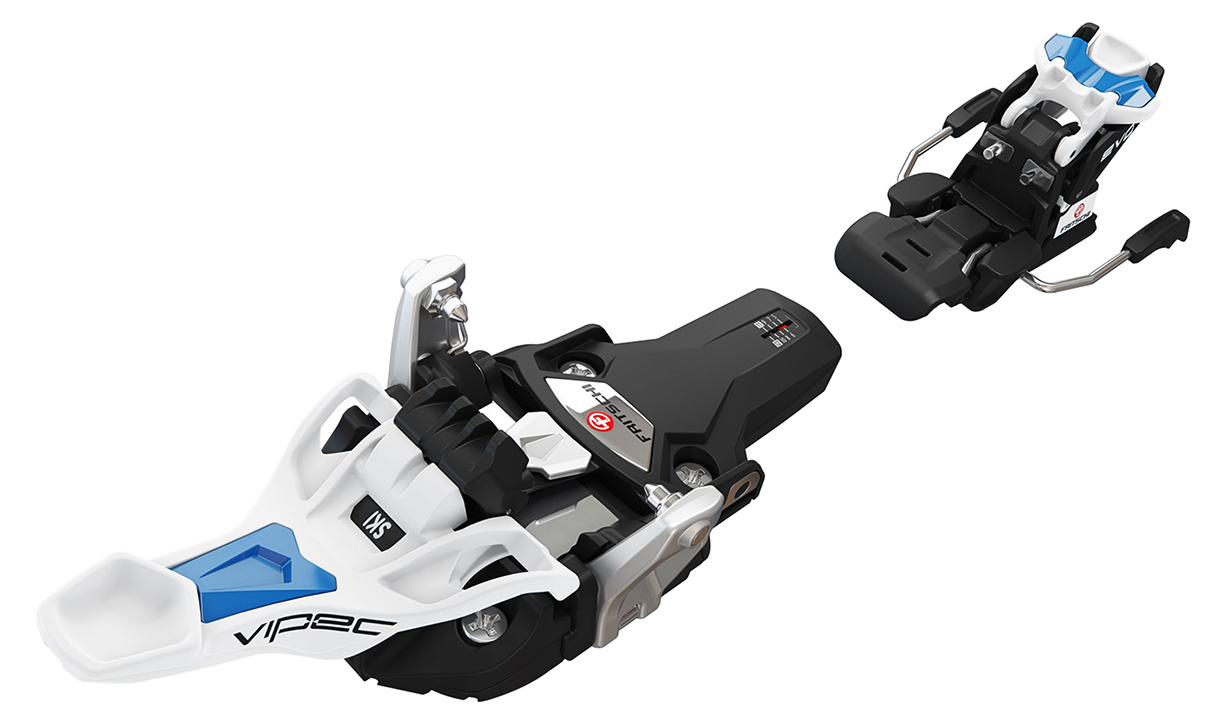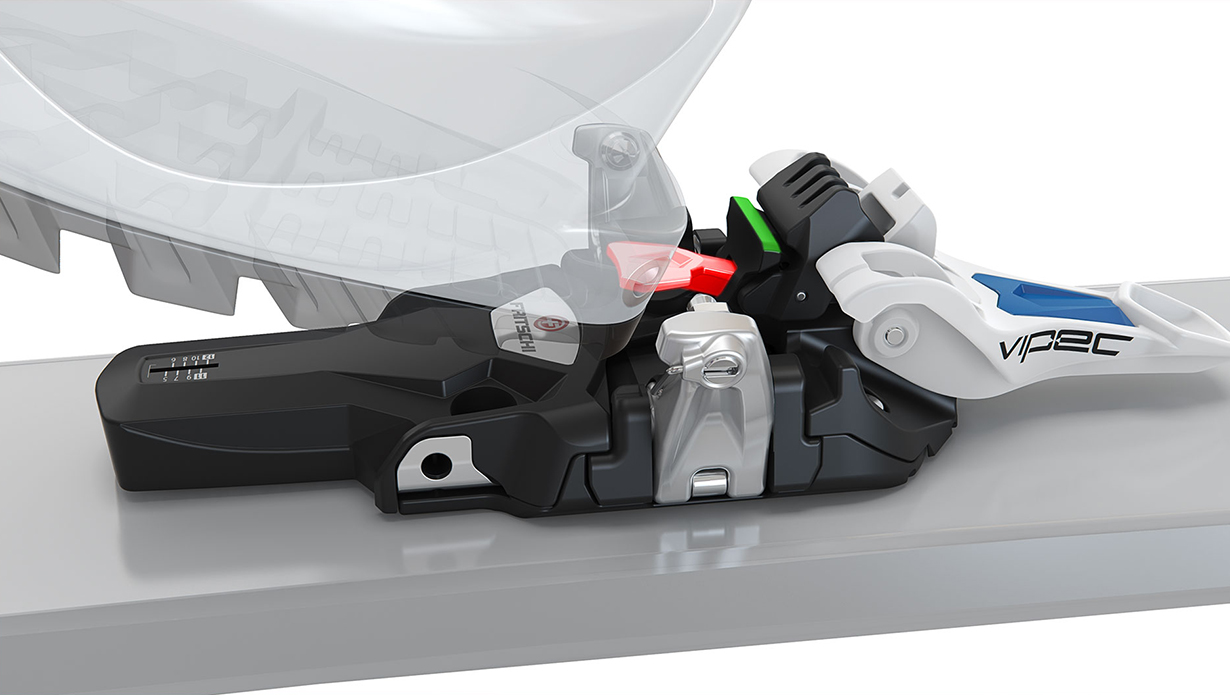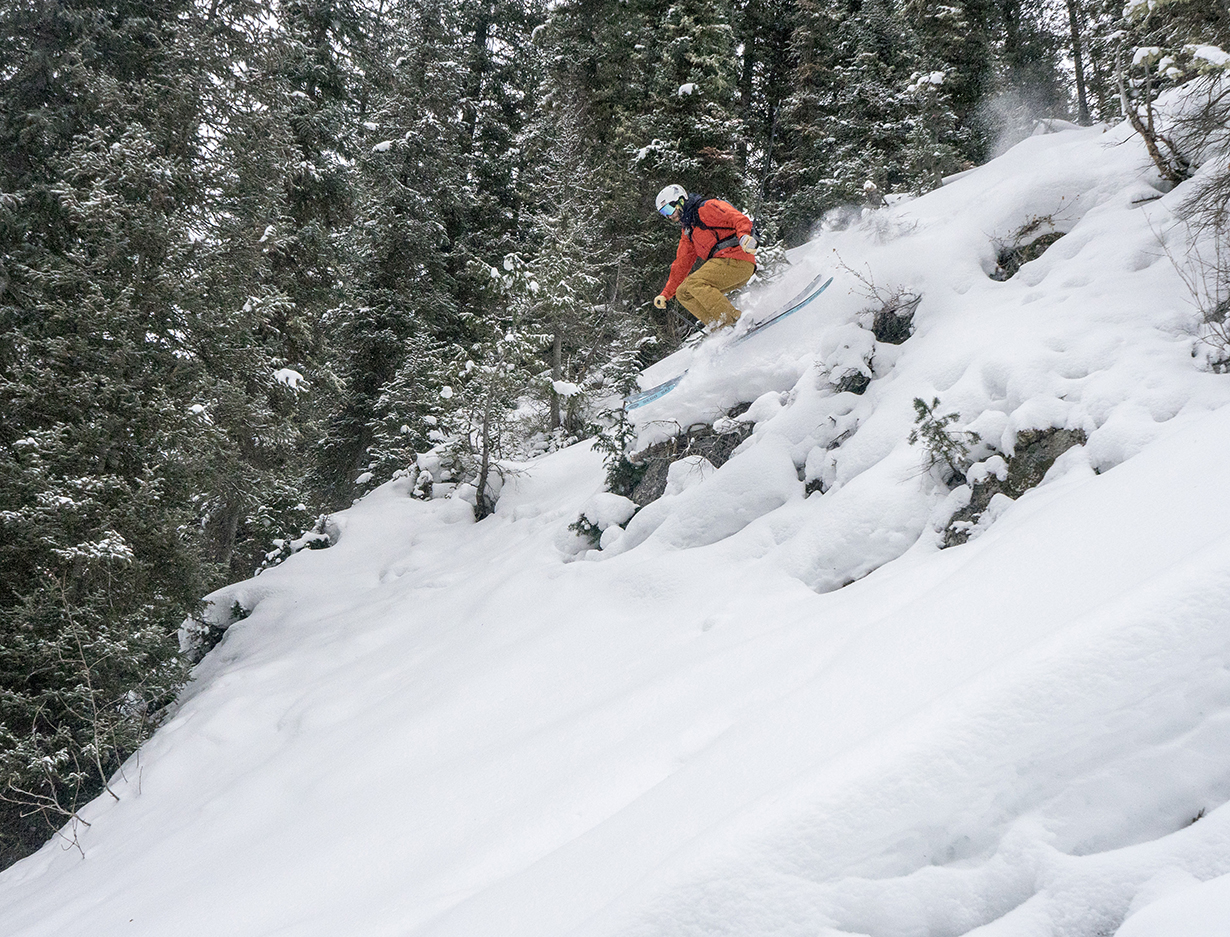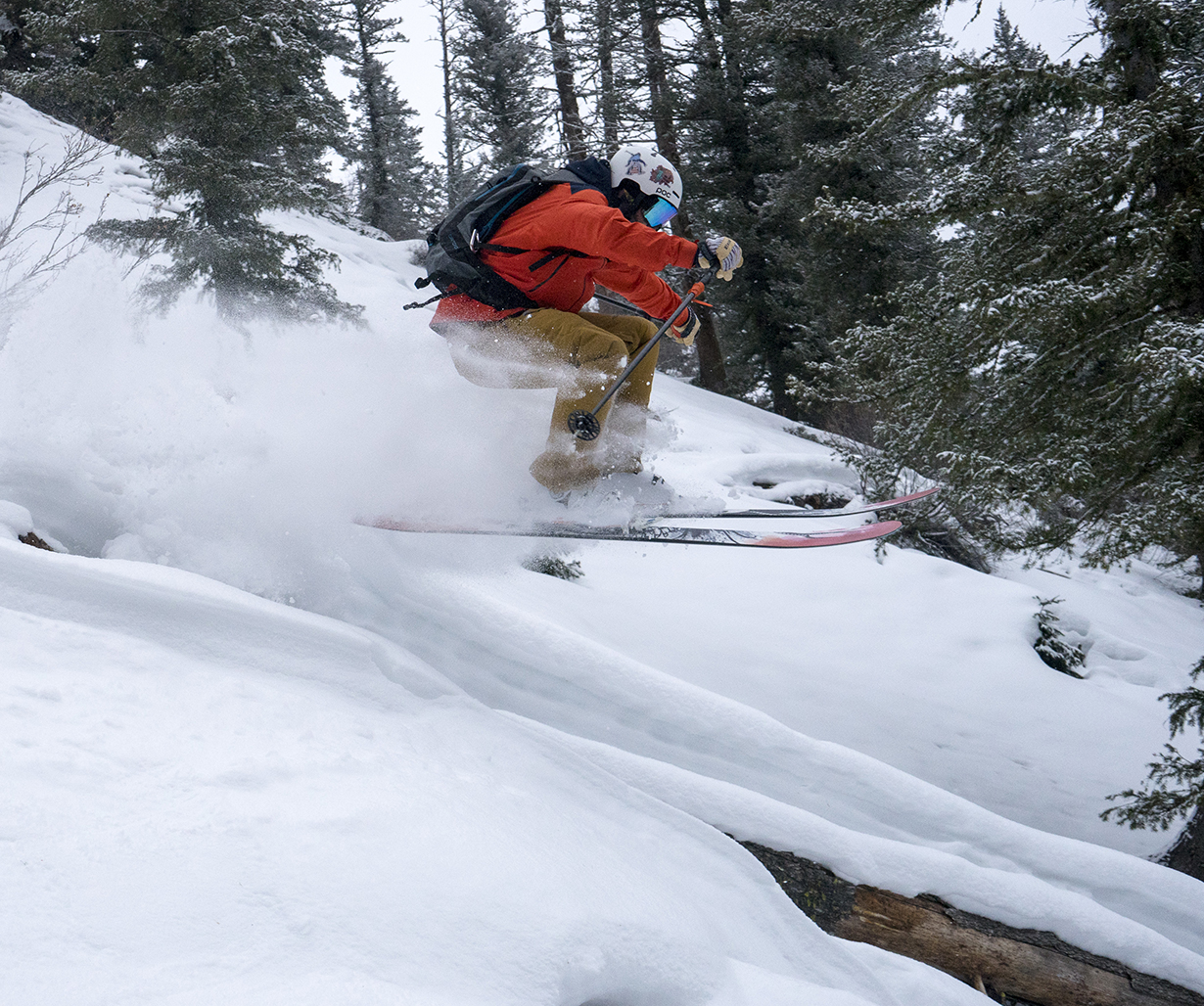
2020-2021 Fritschi Vipec Evo 12
Release value: 5 – 12
Available Brake Widths: 80 mm; 90 mm; 100 mm; 110 mm; 120 mm
Climbing Aids: 2°, 9°, and 13°
Lateral Elasticity (Toe): 13 mm
Vertical Elasticity (Heel): ~2-3 mm
Forward Elasticity: Yes
Stated Weight: 500 g without brakes
Blister’s Measured Weight per binding w/ 110 mm brakes: 595 & 595 grams
MSRP: $599
Skis Used: Sego Big Horn 106, 187 cm
Boots Used: Atomic Hawx Ultra XTD 120
Test Locations: Teton Pass, Grand Targhee Resort, & Ferry Peak Backcountry, WY
Days Tested: 8
[Note: Our review was conducted on the 17/18 Vipec Evo, which was not changed for 18/19, 19/20, or 20/21.]
Intro
Last season we covered the Vipec 12 Black both in a stand-alone review, and in our Deep Dive AT binding shootout, and we came away impressed in both instances. The binding skied well, it was light, and it was affordable.
But for the 17/18 season, Fritschi released the new Tecton 12 as well as an updated Vipec, calling the new binding the “Vipec Evo 12.”
I’ve been touring and skiing inbounds on the new Vipec Evo 12 around the Tetons this season, so I’ll be weighing in on how it compares to the old version, as well as how I think it stacks up against the current crop of bindings.
Deep Dive Comparisons
Become a Blister Member or Deep Dive subscriber to check out our AT Binding Deep Dive where we directly compare the Vipec Evo 12, Fritschi Tecton 12, G3 ION 12, Dynafit ST Rotation, Salomon / Atomic Shift MNC 13, Marker Kingpin, Marker Duke PT, & CAST Freetour, and discuss what you tend to gain and give up by going to much lighter AT bindings.
Vipec Evo 12 — Updates
The new Vipec Evo 12 is advertised as being lighter (50 grams), cheaper ($50), and easier to use than the prior version. This last claim is primarily accomplished through updates to the toe unit of the binding, and the Vipec Evo 12 and the Tecton 12 use the same toe. The prior Vipec used a swappable spacer system to adapt to different boots, but the new Evo toe uses a larger actuation platform that should work with most alpine touring boots right out of the box. Fritschi says that the Evo toe will not work with Dynafit “shark nose” boots like the TLT7, the Scarpa F1 Tronic, and the standard Scarpa Alien. But the non-Tronic Scarpa F1 and Scarpa Alien RS do work with the Evo toe. You can also still adjust the toe wings of the Evo toe piece, but I didn’t need to.

So what does this all translate to on the hill? I found that the Vipec Evo 12 toe is a little easier to get into than the previous Vipec Black toe, and I appreciate the eliminated fiddle-factor of the spacers. It’s still not quite as easy for me to get my toe into the Vipec Evo (especially in deep snow) as it is with the G3 ION or Marker Kingpin, but it’s not much more difficult, and I think most people should adapt to it just fine. It just takes a little more finesse to get those wings to snap shut, and I’ve found that the toe doesn’t stay open (when I’m trying to get my boot into it) as well as other tech bindings I’ve used.
The Vipec Evo 12 also comes with what I’m calling the “vanity package.” You can swap a piece of plastic in the toe lever and in the heel riser to display some different colors if you so desire. Personally, I don’t; I love playing with Legos, but I don’t feel the need to do so with my ski bindings. But if you want that perfectly color-matched look, this is the binding for you.
Touring
Of all the tech bindings I’ve used so far, the Vipec Evo is the easiest to transition in. The lever to push the heel from ski to walk mode is easily accessed, and it makes an nice “thunk” noise that lets me know it’s fully engaged. I’ve had no problems with the brake retention mechanism, or with the ski / walk lever.
The risers are also very easy to engage. I can flip them up or down just with the basket on my pole. The only risers I’ve used that are easier to engaged are on the G3 ION.
I haven’t had any trouble with snow or ice jamming up the binding yet, but I’ve been skiing pretty dry snow. So I’ll update this if I run into any issues.
Skiing
When it’s time to rip skins and head downhill, I really appreciate the Vipec Evo’s easy-to-access transition lever. It feels a little plasticy, but it’s so much easier to use than anything else I’ve skied.
I put the Vipec Evo on a pair of light inbounds skis (Sego Big Horn 106) because I really like having a solid, jibby ski in the backcountry, and I don’t mind hauling around a little extra heft. However, I’ve had a couple of backcountry days where the weather didn’t cooperate, so I’ve also skied the Vipec Evo inbounds, too.

And I’ve been impressed by how good the Vipec Evo feels inbounds. I’d agree with Jonathan and Brian that it’s not quite a Kingpin, but it’s close, and it’s definitely close enough for me. This setup also reminded me how much more the ski I’m on matters to me than the binding I’m on. The Kingpin skis slightly better than the Vipec Evo, but in difficult snow, I’d much rather ski an inbounds ski with the Vipec Evo than a light touring ski mounted with Kingpins. Bindings can only do so much in terms of suspension and shock absorption, and in my experience, the ski makes a much bigger difference.
Of course, the Vipec Evo isn’t really supposed to be competing with the Kingpin — that’s the domain of its heftier brother, the Techton 12. But when compared to the G3 ION or Dynafit Radical 2.0, the Vipec Evo offers a ride that’s much more reminiscent of an alpine binding.
Durability
When I first took it out of the box, I commented that the Vipec Evo 12 felt like it was made out of Legos. It’s made of a lot of plastic, more so than any other tech binding I’ve used. That’s fine, as long as none of that plastic breaks, especially while out on a long tour. The most obvious point of weakness seems to be the length adjustment — I’m just a little leery of those plastic-on-plastic threads, and I take extra care to be gentle adjusting it. But I haven’t had any issues so far.
I did have an issue with the risers on the Vipec Evo. After a couple miles of bootpacking with the skis on my back, we finally hit consistent snow, and I clicked into the bindings to start skinning. But the tall heel riser on my right binding had popped out and fell off when I started skinning. It wasn’t broken at all, it had just somehow come dislodged from the binding (perhaps in the car) or when the skis were strapped to my pack. I was able to snap the riser back into place and it works just fine now, but it didn’t inspire much confidence, especially since I couldn’t pinpoint an impact that could have caused the issue.

The risers on the Vipec Evo feel lighter and flimsier than the risers on any other touring binding I’ve used. They are very easy to flip up and down, but they do seem to be the weak point of this binding. So I’ll be taking extra care with the risers from now on, and will report back if I have any other issues.
Bottom Line
The split in tech bindings seems to grow, especially as more options continue to be unveiled. On one end of things, relatively light bindings (like the G3 ION and Dynafit Radical 2.0) ski remarkably well. They’ll never be race-binding light, but they’re light enough to satisfy most backcountry skiers. On the other end of the spectrum, options like the Marker Kingpin, Fritschi Tecton, and the new Salomon/Atomic SHIFT binding are a little (or a lot) heavier, but ski much more like inbounds bindings.
The Fritschi Vipec Evo 12 falls somewhere between these categories, and I would argue, combines the best aspects of both. The Vipec Evo has the low weight and the low fiddle factor that makes it a fine choice for big, strenuous tours, but it skis nearly as well as much heavier bindings. That makes it a fantastic choice for a wide range of skiers, and its competitive price point only adds to its appeal.
Deep Dive Comparisons
Become a Blister Member or Deep Dive subscriber to check out our AT Binding Deep Dive where we directly compare the Vipec Evo 12, Fritschi Tecton 12, G3 ION 12, Dynafit ST Rotation, Salomon / Atomic Shift MNC 13, Marker Kingpin, Marker Duke PT, & CAST Freetour, and discuss what you tend to gain and give up by going to much lighter AT bindings.

Do you have any idea what is different in the Tecton toe piece? There seems to be a 65 – 70 g difference in weight per piece.
i think it is just a measuring or more probably typing error – the toe pieces are identical. Fritschi/BD states the weight at 500gr sans brakes, which indicates that the tecton weight is the correct one – not the weight above. I also concur with the sentiments above – the vipecs skis excellently for their intended use and are much better safety wise than the comparable competition. I too have had the risers pop off, but it is a super easy fix. And yes, the new evo/tecton front is a lot easier to get into and release even better vertically – so much so that i ended up getting more tectons than originally was the plan. I wholeheartedly recommend the vipecs/tectons :)
I’ve having issues with Evo brakes: when skinning in walk mode they deploy very easily. Slight tap from a tree branch or my other ski and down it goes. Breaking trail and putting in a kick turn… down it goes. This is driving me crazy. Is anyone else having this issue? I have two pairs of Evos and all 4 skis are problematic. Also, Fritshi seems adamant that the binding only be used with brakes so technically I can’t even remove them.
Yes, the plastic piece that holds the brake will eventually fail. Mine did on both my skis. It’s unfortunately just a design flaw. If you notice the way it works: in uptrack mode, you can step on the brake to get it locked up, by doing so, pieces of plastic must spread open to let the brake arms in. Doing this action repeatedly will have the flexing plastic eventually stress fracture. It happened to mine until the brakes did not hold up at all.
I almost pulled a trigger on Salomon SHIFT preorder but I’m thinking now… Is it better to have Vipec and a dedicated alpine binding with quiver killer inserts and swap instead of a hybrid like SHIFT considering price is the same? That is for one 50/50 ski. Where I live it’s almost more than enough :D How much better does Vipec tour in your opinion to justify swap fiddling factor?
Hi,
Pretty sure that toe was redesigned for season 2018/2019. Seems to deal with the “toe dent” issue reported previously. Check it out!
I have exactly the same problem as Matt with the brakes deploying with the slightest tap or hitting a hard patch.
Is there anyway to adjust them so they are less sensitive?
Any advice appreciated.
I have the same issue with breaks releasing as Matt and Peter. Any advice on how this could be fixed would be appreciated.
I find the brakes hold better if you push the heel release down a bit harder. Often the first push does not fully engage the brake retention, but after a second push I don’t have an issue
The new 19/20 toe piece is way better than the 17/18 and 18/19 version in my opinion. More range of motion while walking. They are not identical!
Is it realistic to transition from skin to ski mode without removing the ski as you can do w/ something like a Dynafit Radical?
Yes. Lock the heels to control the ski, rip off the skins.
Yes you can train Stijn to ski mode whiteout stepping out of the binding/ski, then rip skins.
My 12 year old could do this on her first try with the Vipec Evo’s
Heading away from the vipecs to Plum Guides. Skied on the older model (2015) and consistently had a problem with premature heel release when in downhill mode and now the lock on one of the front levers keeps releasing,leading to boot release when skinning. I’ve broken the plastic heel risers in the cold too. I like the rear bind lock/release method compared to the towers but ultimately I expected a more robust performance that didnt really materialize.